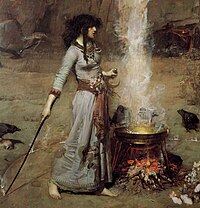 Global Information
Global InformationEuropean witchcraft information

| Part of a series on |
| Witchcraft |
|---|
 |
|
European witchcraft is a multifaceted historical and cultural phenomenon that unfolded over centuries, leaving a mark on the continent's social, religious, and legal landscapes. The roots of European witchcraft trace back to classical antiquity when concepts of magic and religion were closely related, and society closely integrated magic and supernatural beliefs. Ancient Rome, then a pagan society, had laws against harmful magic. In the Middle Ages, accusations of heresy and devil worship grew more prevalent. By the early modern period, major witch hunts began to take place, partly fueled by religious tensions, societal anxieties, and economic upheaval. Witches were often viewed as dangerous sorceresses or sorcerers in a pact with the Devil, capable of causing harm through black magic.[1] A feminist interpretation of the witch trials is that misogynist views of women led to the association of women and malevolent witchcraft.[1]
One pivotal text that shaped the witch-hunts was the Malleus Maleficarum, a 1486 treatise that provided a framework for identifying, prosecuting, and punishing witches. The burgeoning influence of the Catholic Church led to a wave of witch trials across Europe. Usually, accusations of witchcraft were made by neighbours and followed from social tensions. Accusations often targeted marginalized individuals, including women, the elderly, and those who did not conform to societal norms. Women made accusations as often as men. The common people believed that magical healers (called 'cunning folk' or 'wise people') could undo bewitchment. These magical healers were sometimes denounced as harmful witches, but seem to have made up a minority of the accused. The witch-craze reached its peak between the 16th and 17th centuries, resulting in the execution of tens of thousands of people. This dark period of history reflects the confluence of superstition, fear, and authority, as well as the societal tendency to find scapegoats for complex problems.
The Tsardom of Russia also experienced its own iteration of witchcraft trials during the 17th century. Witches were often accused of practicing sorcery and engaging in supernatural activities, leading to their excommunication and execution. The blending of ecclesiastical and secular jurisdictions in Russia's approach to witchcraft trials highlighted the intertwined nature of religious and political power during that time. As the 17th century progressed, the fear of witches shifted from mere superstition to a tool for political manipulation, with accusations used to target individuals who posed threats to the ruling elite.
Since the 1940s, neopagan witchcraft movements have emerged in Europe, seeking to revive and reinterpret ancient pagan and mystical practices. Wicca, pioneered by Gerald Gardner, stands out as one of the most influential neopagan traditions. Drawing inspiration from ceremonial magic, historical paganism, and the now-discredited witch-cult theory, Wicca emphasizes a connection to nature, the divine, and personal growth. Similarly, Stregheria in Italy reflects a desire to reconnect with the country's pre-Christian spiritual roots. Many of these neopagans choose to self-identify as "witches." Contemporary, neopagan witchcraft in Europe encompasses a wide range of traditions, reflecting a blend of historical influences, modern interpretations, new religious movements, and a search for spiritual authenticity in a rapidly changing world.
- ^ a b Ehrenreich, B.; English, D. (2010). Witches, Midwives, & Nurses: A History of Women Healers (2nd ed.). New York: Feminist Press at CUNY. pp. 29, 54. ISBN 978-1558616905.